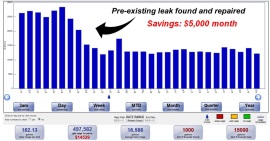by Brianna Crandall — June 1, 2015—On the heels of California Governor Jerry Brown’s statewide water restriction policy and goal to reduce consumption by 25 percent, Atlanta-based WaterSignal announced a service expansion to California to assist those properties included in the mandate—universities and commercial properties, among others—to help reduce their water consumption by 14 percent.
WaterSignal is a self-contained, non-intrusive device that continuously measures water flow in real time and sends data wirelessly to a Web site portal to view the water consumption by the month, day, or even down to the hour. With the real-time data analysis designed to conserve water, property managers can proactively “watchdog” their water use, pinpoint areas wasting water, and even detect leaks or water spikes as they occur.
“You can only manage what you measure, and that’s been the problem with properties overusing water,” said Sean Rayborn, WaterSignal sales manager and a Los Angeles native. “In too many cases, property managers simply look at a monthly water bill, compare the cost to the previous month’s, accept the cost, and pay it without question. However, what they don’t realize is that small underground leaks, inefficient fixtures, and bad landscaping practices have consumed too much water.
“When you have thousands of properties not monitoring how much they actually waste, it’s easy to understand why my home state and others like it succumb to droughts and are forced to take government action to get people actively involved in water conservation.”
 WaterSignal says this commercial property believed that 25,000 gallons of water per month was average, and paid it for years. But WaterSignal found a leak that decreased the usage to 15,000 gallons, for a monthly savings of $5,500, or $66,000 per year.
WaterSignal says this commercial property believed that 25,000 gallons of water per month was average, and paid it for years. But WaterSignal found a leak that decreased the usage to 15,000 gallons, for a monthly savings of $5,500, or $66,000 per year.(Click on image to enlarge)
Using real-time water data, the system creates statistical charts to provide a quick comparative view of gallons used, whether any day or hour had excessive use, and if non-occupied days (weekends/holidays) recorded higher than normal use. The manager can compare usage of one building against another building—or one section of the property versus another—and even compare their data against national standards to determine if their program is on par or if changes need to be made to conserve water and money.
If a leak occurs or when water spikes above the preset hourly or daily limit, the device detects the problem and immediately notifies the manager—much like an energy surge that pops a circuit breaker—via a smartphone and SMS text alert for immediate action.
Rayborn noted that WaterSignal’s average savings is 14 percent.
With the addition of California, WaterSignal is currently working in 16 states, with more than 600 water-monitoring meters installed. Facilities managers are encouraged to check with the company to see whether the system is currently available in their state.





